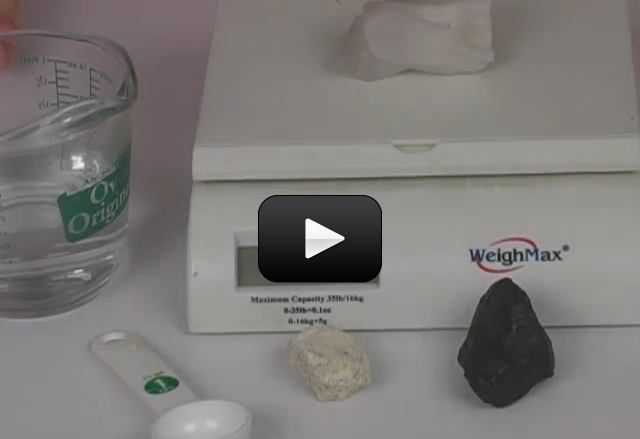Density can be found by weighing an object and dividing by the volume of the object, and for geologists, is the same thing as specific gravity. Water has a density of 1, which means that 1 gram of water takes up 1 cubic centimeter of space. Specific gravity is a number you get when you divide the density of an object by the density of water, which happens to be 1 gram/cm3.
[am4show have=’p8;p9;p30;p57;p79;’ guest_error=’Guest error message’ user_error=’User error message’ ]
Materials
- Measuring cup that has graduation marks for milliliters (mL)
- Scale that measures in grams
- Rock samples (in the video: quartz, meteorite, pumice)
Download worksheet and exercises
The specific gravity (also called the “s.g.” or “SG”) of a mineral or rock is how we compare the weight of the sample with the weight of an equal volume of water. Low specific gravity substances, like pumice (0.9), are not very dense. High specific gravity substances, like for gold (19.3), are very dense. If the specific gravity is less than 1, it will float on water.
Density is a way to measure two different minerals that might be exactly the same size, but their weights are different. Minerals with a metallic luster tend to be heavier. You’ll find variations for SG within the same minerals due to impurities of the mineral. Along those lines, this test can’t be done for material that is embedded within a rock, only for a single sample.
Here are a few examples for you to compare your samples with:
- Amber 1.1
- Quartz 1.5
- Obsidian 2.5
- Amethyst 2.6
- Diamond 3.5
- Hematite 5.05
- Pyrite 5.1
- Gold 19.3
- Label and number each of your samples and record this on your data table.
- Weigh each sample and record the information on your table.
- Fill your cup with water and note the level.
- Completely submerge your sample and read the new water height.
- Subtract #4 from #3 answers to get the amount of water your sample displaces. Record this in your data table.
- Find the volume of water displaced for every sample.
- Divide the mass of the object by the volume to find the density: ρ = m / V with the units of grams / mL
- Note: 1 mL = 1 cm3
Exercises
- In your data table, which number was the same for every trial run?
- What is the equation for finding density?
- How did you find the volume of the rock?
[/am4show]

